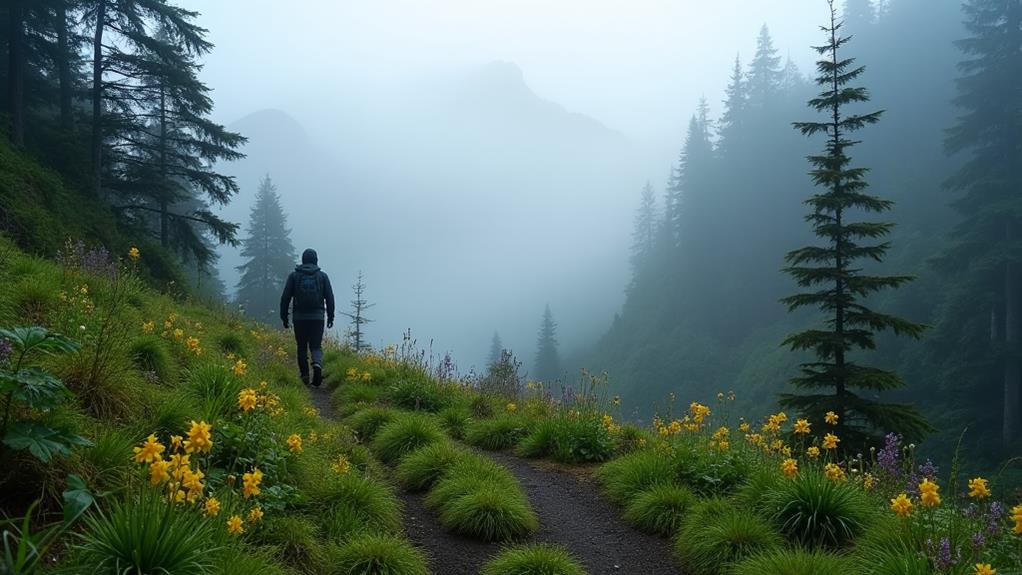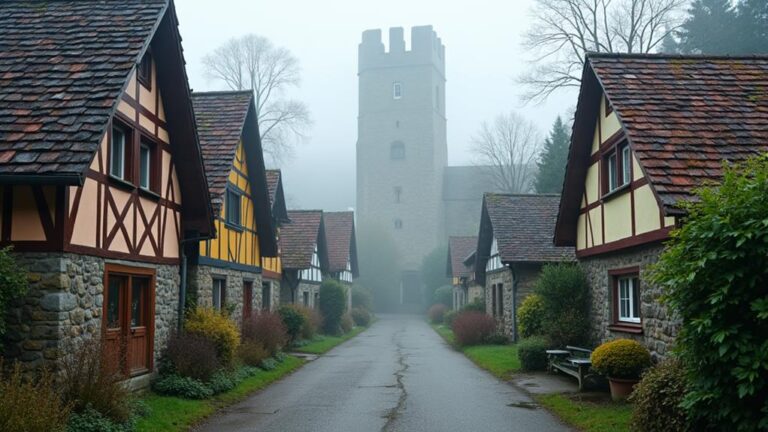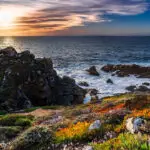With over 70 miles of coastline and 3,200 square miles of diverse landscapes, Olympic National Park offers an unparalleled experience for nature lovers. You'll have the chance to hike through mountains and rainforests, explore tidepools and rugged coastlines, and spot an array of wildlife in their natural habitats. But what specific experiences should you prioritize to make the most of your visit? From witnessing breathtaking vistas to encountering bioluminescent organisms, the park has something for every nature enthusiast. To discover the ultimate Olympic National Park itinerary, let's start by exploring its most unique attractions.
Contents
- 1 Key Takeaways
- 2 Explore Hurricane Ridge Mountains
- 3 Hike the Hoh Rainforest Trails
- 4 Discover Tidepools at Kalaloch
- 5 Spot Wildlife at Lake Quinault
- 6 Visit the Olympic Coast Beaches
- 7 Walk the Hall of Mosses Trail
- 8 Kayak Lake Crescent's Calm Waters
- 9 Witness Bioluminescence at Ruby Beach
- 10 Frequently Asked Questions
- 10.1 What Accommodations Are Available Near Olympic National Park?
- 10.2 Are Pets Allowed on Park Trails and Beaches?
- 10.3 Can I Fish in Olympic National Park's Lakes and Rivers?
- 10.4 What Safety Precautions Should I Take During a Park Visit?
- 10.5 Are Guided Tours Available for Park Activities and Trails?
- 11 Conclusion
Key Takeaways
- Explore Hurricane Ridge Mountains for breathtaking vistas and diverse wildlife.
- Hike the Hoh Rainforest Trails to experience unique ecosystems and diverse plant life.
- Discover Tidepools at Kalaloch to see anemones, sea stars, and other marine life.
- Spot wildlife at Lake Quinault, including bald eagles, black bears, and river otters.
- Kayak Lake Crescent's calm waters for nature watching and photography opportunities.
Explore Hurricane Ridge Mountains
From atop Hurricane Ridge, you'll be surrounded by mountains in every direction, with the Olympic Mountains unfolding before you and the Strait of Juan de Fuca glimmering in the distance.
This rugged landscape offers breathtaking mountain vistas that make it an ideal destination for nature enthusiasts.
During the summer months, the area transforms into a colorful tapestry of alpine wildflowers, with species like bear grass, lupine, and wild roses dotting the landscape.
As you explore the Hurricane Ridge Mountains, you'll have access to various trails that cater to different skill levels and interests.
The Hurricane Hill Trail, a 3.2-mile round-trip hike, takes you through alpine meadows and offers stunning views of the surrounding mountains.
The Klahhane Ridge Trail, on the other hand, is a more challenging 5.5-mile round-trip hike that rewards you with panoramic views of the Olympic Mountains.
Whether you're a seasoned hiker or just looking for a leisurely stroll, Hurricane Ridge has something for everyone.
Be sure to bring your camera to capture the awe-inspiring scenery and diverse wildlife that inhabit this unique ecosystem.
Hike the Hoh Rainforest Trails
As you step into the Hoh Rainforest, you'll be surrounded by one of the largest temperate rainforests in the United States, offering a unique chance to experience the region's diverse ecosystems up close.
To make the most of your hike, mastering the rainforest's intricate ecosystem, including the towering trees, understory plants, and microorganisms that call this forest home, is vital.
Rainforest Ecosystems Uncovered
You're about to immerse yourself in one of the most biologically diverse ecosystems on the planet: the Hoh Rainforest.
As you explore the Hoh Rainforest Trails, you'll discover a unique world of Foggy Canopies and Ancient Roots.
The rainforest's incredible biodiversity is supported by a complex web of relationships between plants, fungi, and animals.
- High levels of rainfall: The Hoh Rainforest receives over 140 inches of rain per year, creating a humid environment that supports lush vegetation.
- Dense canopy: The rainforest's canopy is made up of towering conifers and broadleaf trees, blocking out much of the sunlight and creating a shaded understory.
- Complex root systems: The Ancient Roots of the rainforest's trees play a vital role in supporting the ecosystem, with some trees' roots stretching for hundreds of feet.
- Rich soil: The rainforest's soil is teeming with life, from fungi and bacteria to insects and small animals, all working together to break down organic matter and recycle nutrients.
As you hike through the Hoh Rainforest, take time to appreciate the intricate relationships between the plants and animals that call this ecosystem home.
Wildlife Viewing Tips
Hiking the Hoh Rainforest Trails offers a unique opportunity to catch a glimpse of the wildlife that inhabits this lush ecosystem.
As you walk through the misty forest, keep your eyes peeled for Roosevelt elk, black-tailed deer, and black bears. You may also spot smaller creatures like Douglas squirrels and banana slugs.
For avid bird watchers, the Hoh Rainforest is a paradise.
The area is home to over 300 species of birds, including the marbled murrelet, northern spotted owl, and pileated woodpecker. Bring a pair of binoculars to get a closer look at these feathered friends.
If you're visiting the coast, look out for marine life like sea otters, seals, and harbor porpoises. You may even catch a glimpse of a gray whale migrating through the waters.
When wildlife viewing, remember to keep a safe distance and respect the animals' space.
Avoid making loud noises or sudden movements that may scare them away. Bring a field guide or consult with park rangers to learn more about the wildlife that inhabits the park.
Your Hoh Rainforest trail navigation begins with a map and compass, essential tools for traversing the park's vast and varied terrain.
Familiarize yourself with the map, paying attention to trail markers, elevation changes, and potential hazards.
Understand that the map isn't a substitute for common sense and awareness of your surroundings.
- Know your route: Study the map to understand the trail's layout, including any intersections or potential detours.
- Identify landmarks: Take note of distinctive features, such as rivers, lakes, or mountain peaks, to help guide you.
- Recognize trail markers: Pay attention to signs, blazes, or other markers that indicate the trail's direction and difficulty level.
- Monitor your progress: Use your map and compass to track your progress, making adjustments as needed to stay on course.
Map reading is a critical skill when hiking in the Hoh Rainforest.
By combining your map with a compass and awareness of your surroundings, you'll be better equipped to navigate the trails and enjoy the park's stunning natural beauty.
Always bring a map and compass with you, and know how to use them to guarantee a safe and enjoyable hike.
Discover Tidepools at Kalaloch
The rugged shoreline of Kalaloch, a scenic coastal area within Olympic National Park, beckons exploration of its fascinating tidepools. As you explore the tidepools, you'll discover an array of marine life, including anemones, sea stars, and mussels. To safeguard the tidepools remain healthy and thriving, practice good tidepool etiquette by not touching or disturbing the creatures, and never removing them from their habitat.
Beachcombing secrets abound in Kalaloch, where you can find interesting shells, sea glass, and driftwood. To make the most of your tidepooling experience, visit during low tide, when the most marine life is exposed.
| Tidepool Tip | Marine Life | Best Time to Visit |
|---|---|---|
| Explore gently, avoiding disturbance | Anemones, sea stars, mussels | Low tide, when most marine life is exposed |
| Keep your hands and feet away from creatures | Sea slugs, sea urchins, fish | Early morning, when tidepools are calmest |
| Never remove creatures from their habitat | Crabs, sea cucumbers, seaweed | Late afternoon, when tidepools are most active |
Spot Wildlife at Lake Quinault
As you explore the natural beauty of Olympic National Park, Lake Quinault's tranquil atmosphere and diverse wildlife await your discovery.
This stunning lake is a haven for nature lovers, offering a serene and peaceful environment to spot a wide variety of wildlife.
The lake's tranquility is a perfect setting to unwind and connect with nature.
Some of the amazing wildlife you can spot at Lake Quinault include:
- Bald Eagles: Soar above the lake and surrounding forests, scanning for their next meal.
- Quinault Birds: Over 200 species of birds, including the spotted owl, marbled murrelet, and pileated woodpecker, call the lake and its surroundings home.
- Black Bears: These majestic creatures roam the forests surrounding the lake, searching for food and shelter.
- River Otters: Playfully swim in the lake, adding to its natural charm.
Lake Quinault's diverse wildlife and serene atmosphere make it an ideal destination for nature lovers and wildlife enthusiasts.
As you explore the lake's surroundings, keep your eyes peeled for these amazing creatures, and take in the tranquility of this natural wonder.
Visit the Olympic Coast Beaches
Surrounded by rugged cliffs and rocky tidepools, the Olympic Coast beaches offer a dramatic and unspoiled shoreline experience.
You'll find rugged beauty and tranquility as you explore the 70 miles of coastline within Olympic National Park. Witness the power of coastal erosion firsthand, where the ocean relentlessly carves away at the shoreline, creating unique rock formations and tidepools.
As you walk along the beaches, you'll discover hidden coves and isolated stretches of sand, perfect for a peaceful day of beachcombing.
Beachcombing adventures await you, with a wide variety of seashells, driftwood, and other ocean treasures to discover. Keep an eye out for marine life, including anemones, starfish, and mussels in the tidepools.
Be sure to check the tide times before you go, as some beaches are only accessible at low tide. Also, be mindful of the rugged terrain and stay safe by watching your step on the slippery rocks and steep cliffs.
With its unspoiled beauty and abundant wildlife, the Olympic Coast beaches are a must-visit destination for nature lovers.
Walk the Hall of Mosses Trail
What draws you to a forest's most enchanting features?
For many, it's the immersive experience of walking through a mossy forest.
The Hall of Mosses Trail, a 0.8-mile loop in the Hoh Rainforest, offers just that.
As you step into this mystical world, the sounds of the forest surround you, and the scent of damp earth fills your senses.
- Moss-covered trees: Witness the towering spruce and fir trees, their branches heavy with moss, creating a surreal landscape.
- Diverse plant life: Explore the forest floor, where you'll find a variety of plants, including ferns, wildflowers, and berry bushes.
- Forest therapy: Experience the calming effects of forest therapy, a practice that promotes well-being and relaxation in nature.
- Wildlife viewing: Keep an eye out for wildlife, such as black bears, Roosevelt elk, and birds, that call the Hoh Rainforest home.
As you walk the Hall of Mosses Trail, you'll be enveloped by the tranquility of the forest.
The trail's gentle slope and short length make it accessible to hikers of all skill levels, allowing you to focus on the serenity of the surroundings.
Kayak Lake Crescent's Calm Waters
Most mornings, Lake Crescent's glassy surface reflects the surrounding mountains like a mirror, creating a serene and breathtaking scene.
As you kayak across the lake's calm waters, you'll feel the tranquility of the surrounding environment. The lake's stillness provides an ideal setting to practice and refine your paddling techniques.
Take your time to glide across the water, observing the surrounding mountains and forests from a unique perspective.
As you paddle, you'll notice the lake's crystal-clear waters, which offer a glimpse into the underwater world.
Keep an eye out for fish swimming beneath your kayak. The lake's calm atmosphere also makes it an excellent spot for nature watching and photography.
Take a moment to appreciate the beauty of the surrounding landscape, and don't hesitate to stop and observe any wildlife you encounter.
To fully experience Lake Crescent's tranquility, consider kayaking during the early morning or late evening hours when the lake is usually at its calmest.
This will allow you to fully immerse yourself in the natural beauty of the lake and its surroundings.
Witness Bioluminescence at Ruby Beach
As the sun sets over Ruby Beach, the evening hours bring a unique opportunity to witness a natural phenomenon – bioluminescence.
This rare occurrence happens when tiny organisms in the water, like dinoflagellates, emit a blue-green light when disturbed. You can experience this magical display by visiting Ruby Beach at night.
To make the most of your bioluminescence experience, consider the following tips:
- Arrive at low tide: Exposed beach areas create more opportunities for bioluminescence to occur.
- Dress warmly and wear layers: It can get chilly at night, even during warmer months.
- Bring a camera with a tripod: To capture the best coastal photography shots, you'll want a stable camera.
- Pack a red light flashlight: White light can disrupt bioluminescence, so use a red light to preserve the display.
If you're planning to stay overnight, consider beach camping near Ruby Beach to maximize your chances of witnessing bioluminescence.
Be sure to follow Olympic National Park's regulations and respect the environment.
With the right conditions and preparation, you'll be able to witness this breathtaking natural light show.
Frequently Asked Questions
What Accommodations Are Available Near Olympic National Park?
You'll find various accommodations near Olympic National Park, including luxury lodges like Sol Duc Hot Springs Resort and Lake Quinault Lodge, as well as numerous camping options, such as Kalaloch Campground and Graves Creek Campground.
Are Pets Allowed on Park Trails and Beaches?
When visiting Olympic National Park with your pet, you'll find that pet rules vary. Pets are generally allowed on beaches, but not on most trails, while service animals are allowed in all areas with you.
Can I Fish in Olympic National Park's Lakes and Rivers?
You can reel in a fresh catch or simply enjoy the serene surroundings while fishing in Olympic National Park's lakes and rivers, but you must follow strict fishing regulations to preserve the ecosystem.
What Safety Precautions Should I Take During a Park Visit?
When visiting Olympic National Park, you should check wildlife warnings and weather forecasts daily. Bring bear spray, stay on trails, and be prepared for changing conditions to guarantee a safe and enjoyable park experience.
Are Guided Tours Available for Park Activities and Trails?
You're in luck, as you'll find expertly curated experiences with park-led excursions. Park Rangers and knowledgeable guides offer Naturalist Insights on various trails and activities, elevating your adventure with insider knowledge and unique perspectives.
Conclusion
As you leave Olympic National Park, the rugged landscape will be etched in your mind like the ancient tree trunks that stand tall in the Hoh Rainforest. The park's diverse ecosystems will have awakened your senses, and the memories of bioluminescent nights and serene lake waters will linger. Like a shell you find on the Olympic Coast Beaches, your experience will be a treasured keepsake, reminding you of nature's beauty and power.









